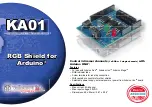
Appendix A: Reducing Electrical Noise
111
Appendix A: Reducing Electrical Noise
Noise-related difficulties can range in severity from minor
positioning errors to damaged equipment from runaway
motors crashing blindly through limit switches. In
microprocessor-controlled equipment such as the 6250,
the processor constantly retrieves instructions from
memory in a controlled sequence. If an electrical
disturbance occurs, it may cause the processor to
misinterpret an instruction or access the wrong data.
This can be catastrophic to the program and force you to
reset the processor.
Sources of Noise
Being invisible, electrical noise can be very mysterious,
but it invariably comes from the following sources:
❏
Power line noise
❏
Externally conducted noise
❏
Transmitted noise
❏
Ground loops
The following electrical devices are notorious for
generating unwanted electrical noise conditions:
❏
Coil-driven devices: conducted and power line noise
❏
SCR-fired heaters: transmitted and power line noise
❏
Motors & motor drives: transmitted and power line noise
❏
Welders (electric): transmitted and power line noise
Power Line Noise
Power line noise is usually easy to resolve due to the
wide availability of line filtering equipment for the
industry. Only the most severe situations call for an
isolation transformer. Line filtering equipment is required
when other devices connected to the local power line are
switching large amounts of current, especially if the
switching occurs at a high frequency.
Any device having coils is likely to disrupt the power line
when it is switched off. Surge suppressers, such as
metal oxide varistors (MOVs) are capable of limiting this
type of electrical noise. A series resistor/capacitor (RC)
network across the coil is also effective (resistance: 500
to 1,000
Ω
; capacitance: 0.1 to 0.2
µ
F). Coil-driven
devices (inductive loads) include relays, solenoids,
contractors, clutches, brakes, and motor starters.
MOV
AC or DC
R
C
Typical RC Network
AC or DC
Inductive
Load
Externally Conducted Noise
Externally-conducted noise is similar to power line noise,
but the disturbances are created on signal and ground
wires that are connected to the 6250. This kind of noise
can get into logic circuit ground or into the processor
power supply and scramble the program. The problem
here is that control equipment often shares a common DC
ground wire that may be connected to several devices,
such as a DC power supply, programmable controller,
remote switches, etc. When a noisy device such as a
relay or solenoid is attached to the DC ground, it may
cause disturbances within the 6250.
To solve a noise problem caused by DC mechanical relays
and solenoids, you can connect a diode backwards
across the coil to clamp the induced voltage
kick that the
coil will produce. The diode should be rated at 4 times the
coil voltage and 10 times the coil current. Using solid
state relays is another way to eliminate this problem.
Diode
DC
Multiple devices on the same circuit should be grounded
together at a single point.
Furthermore, power supplies and programmable
controllers often have DC common tied to Earth (AC
power ground). As a rule, it is preferable to have the 6250
signal ground or DC common floating with respect to
Earth. This prevents noisy equipment which is grounded
to Earth from sending noise into the 6250. When floating
the signal ground is not possible, you should make the
Earth ground connection at only one point.
In many cases, optical isolation may be required to
completely eliminate electrical contact between the 6250
and a noisy environment. Solid state relays provide this
type of isolation.
Transmitted Noise
Transmitted noise is picked up by external connections
to the 6250, and in severe cases can attack the 6250
when there are no external connections. The 6250's
sheet metal enclosure will typically shield the electronics
from this, but openings in the enclosure for connections
and front panel controls may
leak.
When high current contacts open, they draw an arc,
producing a burst of broad spectrum radio frequency
noise that can be picked up on a limit switch or other
wiring. High-current and high-voltage wires have an
electrical field around them and may induce noise on
signal wiring, especially when they are tied in the same
wiring bundle or conduit.
When this kind of problem occurs, you should consider
shielding signal cables or isolating the signals. A proper
shield surrounds the signal wires to intercept electrical
fields, but this shield must be tied to Earth to drain the
induced voltages. At the very least, wires should be run
in twisted pairs to limit straight line antenna effects.
Installing the 6250 in a NEMA enclosure ensures
protection from this kind of noise, unless noise-producing
equipment is also mounted inside the enclosure.
Connections external to the enclosure must be shielded.
Even the worst noise problems in environments near 600
amp welders and 25kW transmitters have been solved
using enclosures, conduit, optical isolation, and single-
point ground techniques.
Ground Loops
Ground Loops are the most mysterious noise problems.
They seem to occur most often in systems where a













































